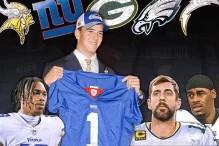

If you’ve ever played Fantasy Premier League, you can play NFL Fantasy. They both work in an incredibly similar way, as you manage teams filled with players who score points based on their in-game performances. You also join leagues to play against your friends and earn those ever-important bragging rights.
But there are a few differences.
Firstly, in NFL Fantasy, the league you join is created by the commissioner for around 10-12 total players.
And just like NFL franchises, your NFL Fantasy team will have to select players through a draft system in order to build your roster. Leagues can either draft in a linear format (whoever picks first in the first round picks first in the second round, and so on) or in a snake format – where each player drafts in a specific order, and then that order is reversed for the next round. The players you draft form the very first version of your team.
Running backs, wide receivers and quarterbacks are considered the most valuable fantasy players, but your team’s starting lineup will, usually, feature:
- – One quarterback.
- – Two running backs.
- – Two wide receivers.
- – One tight end.
- – One flex (a ‘flexible’ spot for either another running back or wide receiver).
- – One kicker.
- – One NFL team’s entire defense.
Your team will also have six backup spots, which you can fill with any positions – although it’s best to fill those places with capable reserves in case of injuries or suspension.
Each week you pick which players you want to start, then face another team in your league. Whichever team scores the most points in that week’s round of games takes the win. This continues for the first 14 weeks of the NFL season, and then the fantasy playoffs begin.
Scoring in NFL Fantasy is like Fantasy Premier League – you score points when a player on your team performs on the field. Each different stat a player, or defense, can accumulate is worth a different amount of points.
Offensive players score:
- – One point for every 25 passing yards.
- – One point for every 10 rushing yards.
- – One point for every 10 receiving yards.
- – One point for every catch.
- – Four points for every passing touchdown.
- – Six points for every rushing touchdown.
- – Six points for every receiving touchdown.
- – Six points for every fumble recovery touchdown.
- – Six points for every kickoff and punt return touchdown.
- – Two points for every two-point conversion.
But they can lose two points for every interception thrown and every fumble lost.
Kickers score:
- – One point for every extra point made.
- – Three points for every field goal made between 1-49 yards.
- – Five points for every field goal made over 50 yards.
Defenses score:
- – One point for every sack.
- – Two points for every interception.
- – Two points for every fumble recovered.
- – Two points for every safety scored.
- – Six points for every defensive touchdown.
- – 10 points for allowing zero points.
- – Seven points for allowing between one-six points.
- – Four points for allowing between 7-13 points.
- – One point for allowing between 14-20 points.
- – Zero points for allowing between 21-27 points.
And just like offensive players, defenses can lose points. They lose one point for allowing between 28-34 points, and lose four points for allowing 35 or more points.
In order for these fantasy points to count, the players or defense must be a part of your starting lineup – if they’re on the bench and one of your starters is injured, or on a bye, they don’t automatically move over, so you need to check your roster before every game.
You can drop and add players before each round of games, doing so with waivers, free agents or trades.
When you drop a player from your team, they head to waivers, where any other team can put in a claim for them. Once every interested team has done so, the one with the worst record gains the player, and if no one was interested, that player becomes a free agent – so anyone in the league can then add them to their team.
NFL Fantasy teams can also trade players, but the league’s commissioner will have to allow it to go through to ensure fairness.
Once your team is set, all you have to do is keep an eye on the scores, and remember, if an NFL player on your roster is having one of the best games of their career – it’s usually good for your fantasy team. In a game against the Carolina Panthers last season, Cincinnati Bengals running back Joe Mixon scored five total touchdowns, adding 153 rushing yards and 58 receiving yards. Mixon ended that week with 55.10 fantasy points, the most of any player in a single week last year.
So no matter who you’re in a league with, have fun – and good luck!
https://decyfrsport.com/decyfrd-nfl-fantasy/
Copied!































































































































